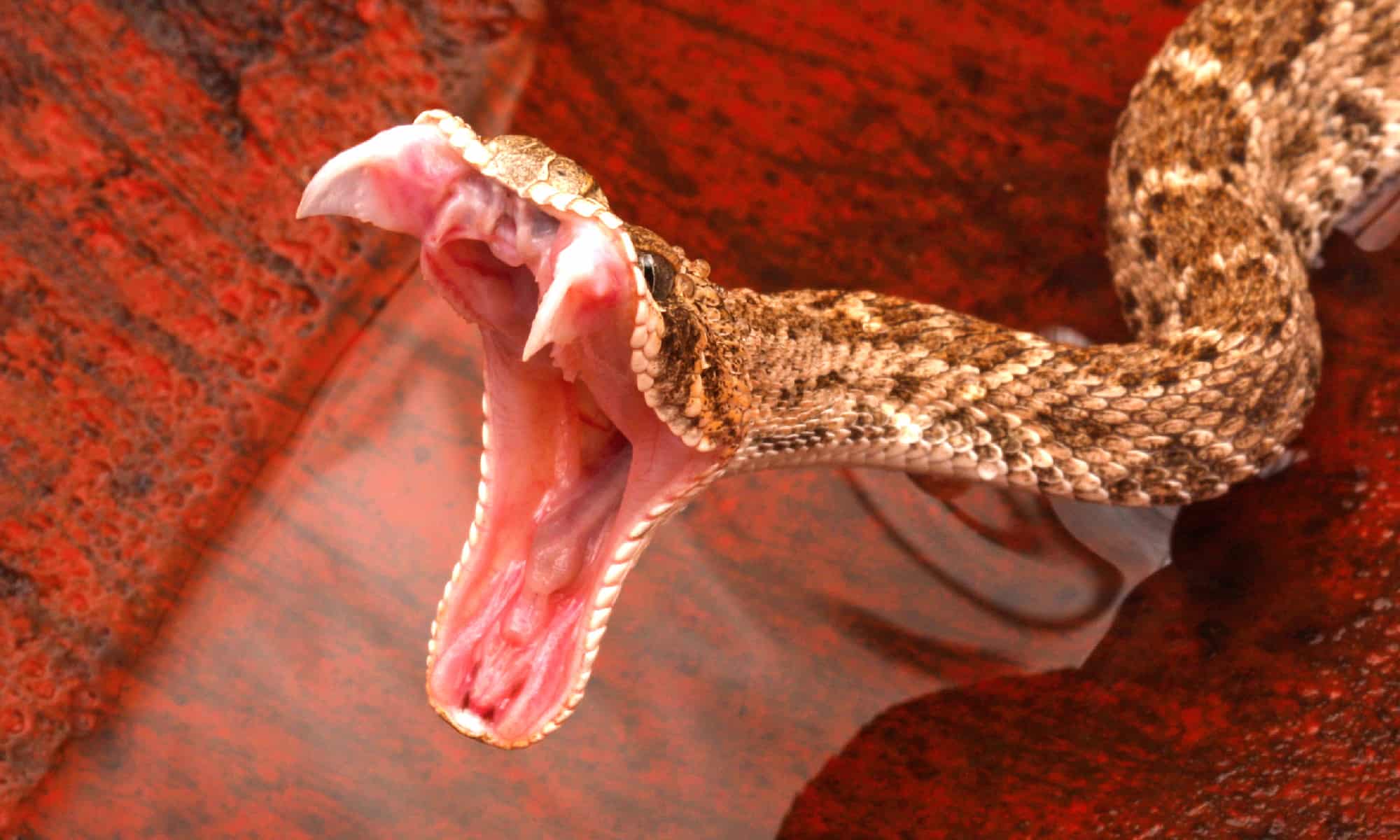Venomous snakes are no joke. In many areas of the United States, one could find a variety of different venomous snakes. In Arizona and California, there are a ton of different fascinating species that are both entrancing and terrifying. When it comes to Arizona vs. California venomous snakes, there is a lot of crossover as well.
Let’s take a look at the venomous snake species in Arizona and California, respectively. Which state do you think has the most venomous snake species?
Venomous Snakes in Arizona
1. Western Diamondback Rattlesnake
Classification: Crotalus atrox
One of Arizona’s most venomous snakes, the Western Diamondback Rattlesnake can be found all across the desert areas of the state. If left untreated, its venom can be very venomous and cause excruciating pain, edema, tissue damage, and even death.
In Arizona, bites from these snakes are rather frequent, especially in the warmer months when they are most active. When spending time outside in rattlesnake habitat, it is crucial for locals and visitors to be aware of the risks posed by these snakes and to take appropriate precautions.

The Western Diamondback Rattlesnake (pictured) is a symbol of Arizona.
©Alexander Wong/Shutterstock.com
2. Arizona Coral Snake
Classification: Micruroides euryxanthus
In the southeast region of Arizona, there is a venomous species of snake called the Arizona Coral Snake. Their neurotoxic venom attacks the neurological system and, if untreated, has the potential to result in respiratory failure. Although these snake bites are uncommon in Arizona, they can be fatal if untreated right away.
The unique red, yellow, and black striping that distinguishes the coral snake makes it easy to spot. People must be aware of these creatures and seek medical help right once if they are bitten by a coral snake or any venomous animal.
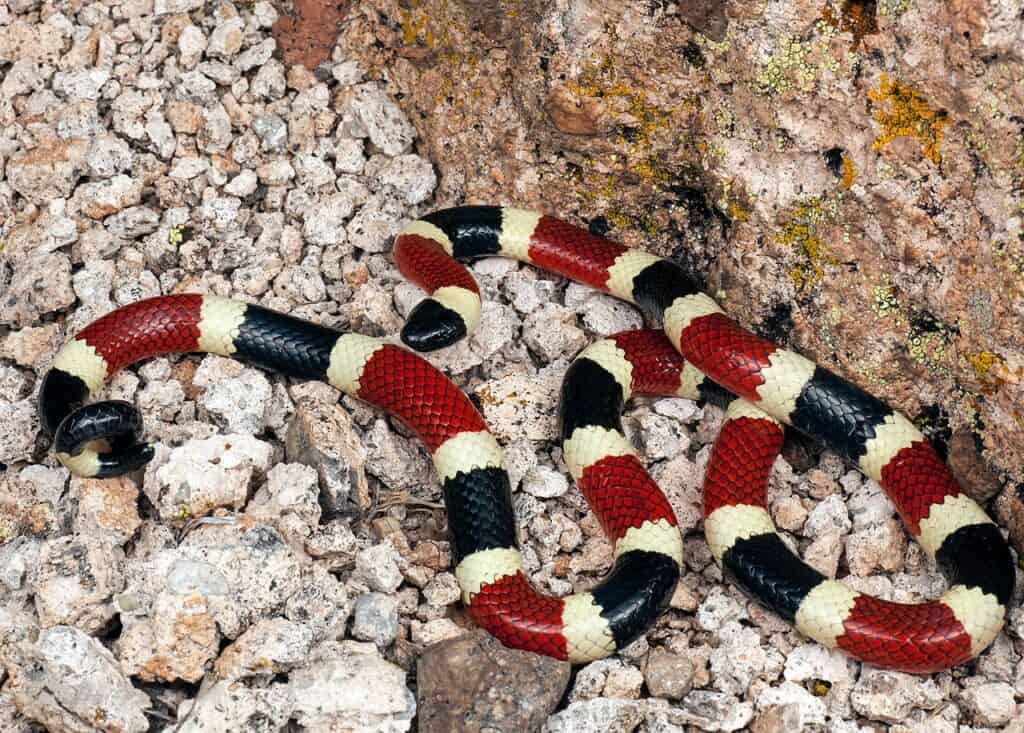
A number of harmless snakes in the same region mimic the Arizona coral snakes colors and patterns imperfectly to fool predators
©CC BY-SA 2.0
3. Rock Rattlesnake
Classification: Crotalus lepidus
The Rock Rattlesnake inhabits the rocky terrain of Arizona in large numbers. The camouflage coloring of the Rock Rattlesnake aids in its ability to blend in with its rocky environment. Compared to other rattlesnake species, its venom is generally mild. But if untreated, it can still result in substantial discomfort, swelling, and tissue damage.
Since these snakes are typically not aggressive toward people and prefer to avoid conflict, bites from them are relatively uncommon in Arizona. However, caution should always be used when coming into contact with any snake in the wild, and if bitten, medical assistance should be sought right once.
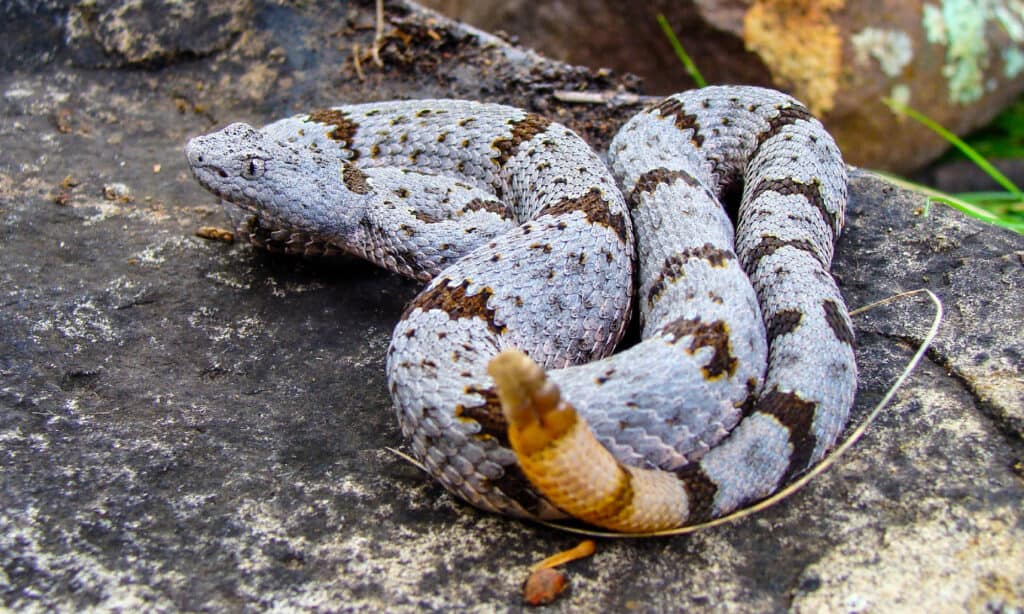
The Rock Rattlesnake (pictured) has a very distinctive coloration that helps in blend in with rocks.
©Matt Jeppson/Shutterstock.com
4. Mojave Rattlesnake
Classification: Crotalus scutulatus
Arizona’s arid areas are home to the deadly Mojave Rattlesnake. Both a hemotoxin and a neurotoxic are present in their venom. In extreme circumstances, their venom can result in respiratory failure, excruciating pain, swelling, tissue damage, and even death.
The severity of its venom makes bites from these snakes especially hazardous, even though they are very infrequent in Arizona. It’s crucial to use caution and get help right away if you get bitten. The Mojave Rattlesnake can be easily identified thanks to its striking black and white banded tail.

The Mojave Rattlesnake (pictured) has the most toxic venom of any Arizona snake species.
©Creeping Things/Shutterstock.com
5. Black-Tailed Rattlesnake
Classification: Crotalus molossus
The mountainous areas of Arizona are home to the venomous Black-Tailed Rattlesnake. Compared to other rattlesnake species, its venom is generally mild. But if untreated, it can still result in substantial discomfort, swelling, and tissue damage. Since these snakes are typically not aggressive toward people and prefer to avoid conflict, bites from them are relatively uncommon in Arizona.
However, caution should always be used when coming into contact with any snake in the wild, and if bitten, medical assistance should be sought right once. The Black-tailed Rattlesnake can be distinguished from other rattlesnake species thanks to its black tail and unusual design.
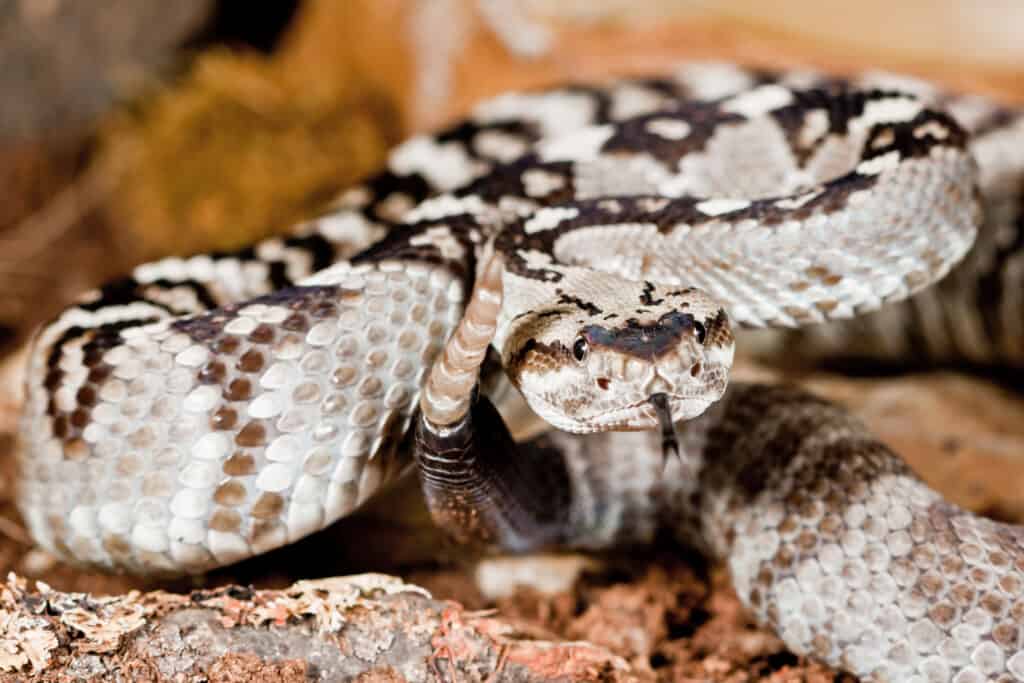
Black-Tailed Rattlesnakes (pictured) are somewhat easier to spot in the wild due to their white coloring.
©iStock.com/pitchwayz
6. Western Massasauga
Classification: Sistrurus tergeminus
In the grassland and riparian regions of Arizona, there is a tiny, venomous species called the Western Massasauga. Compared to other venomous species, its venom is generally weak. However, if left untreated, it can still result in substantial discomfort, swelling, and tissue damage.
Since these snakes are typically timid and non-aggressive toward people, bites from them are relatively uncommon in Arizona. The Western Massasauga is easily recognized because of its tiny size and unusual facial features. These snakes are fairly easy to identify from rattlesnakes out in the desert of Arizona.

Western Massasaugas (pictured) inhabit areas in Arizona, Oklahoma, Texas, Colorado, and Kansas.
©Nick Kanakis/Shutterstock.com
7. Western Rattlesnake
Classification: Crotalus oreganus
The Western Rattlesnake is a venomous species that inhabits a variety of environments in Arizona. If left untreated, its venom can be very venomous and cause excruciating pain, edema, tissue damage, and even death. In Arizona, bites from these snakes are rather frequent, especially in the warmer months when they are most active.
When spending time outside in rattlesnake habitat, it is crucial for locals and visitors to be aware of the risks posed by these snakes and to take appropriate precautions. The brown and grey coloring of the Western Rattlesnake aids in its ability to blend in with its environment. This can make it hard to spot these snakes while hiking. Always be sure to watch your feet when hiking anywhere in the state.
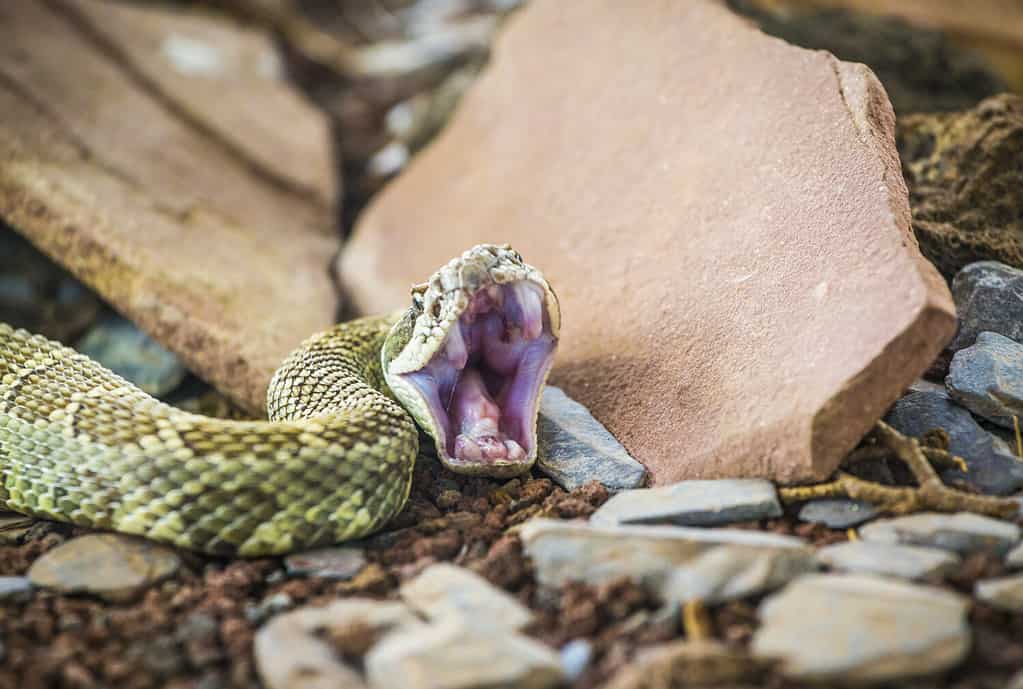
The Western Rattlesnake (pictured) has very large venomous fangs.
©Clement Horvath/Shutterstock.com
8. Hopi Rattlesnake
Classification: Crotalus viridis nuntius
The Hopi Rattlesnake is a venomous species found in Arizona’s rocky areas and canyons. Their venom is relatively mild compared to other rattlesnake species, but can still cause significant pain, swelling, and tissue damage if left untreated. Bites from these snakes are relatively rare in Arizona, as they are generally shy and non-aggressive towards humans. The Hopi Rattlesnake’s distinctive coloration, including black and white banding and red-orange tail, is how one can identify them in the wild.
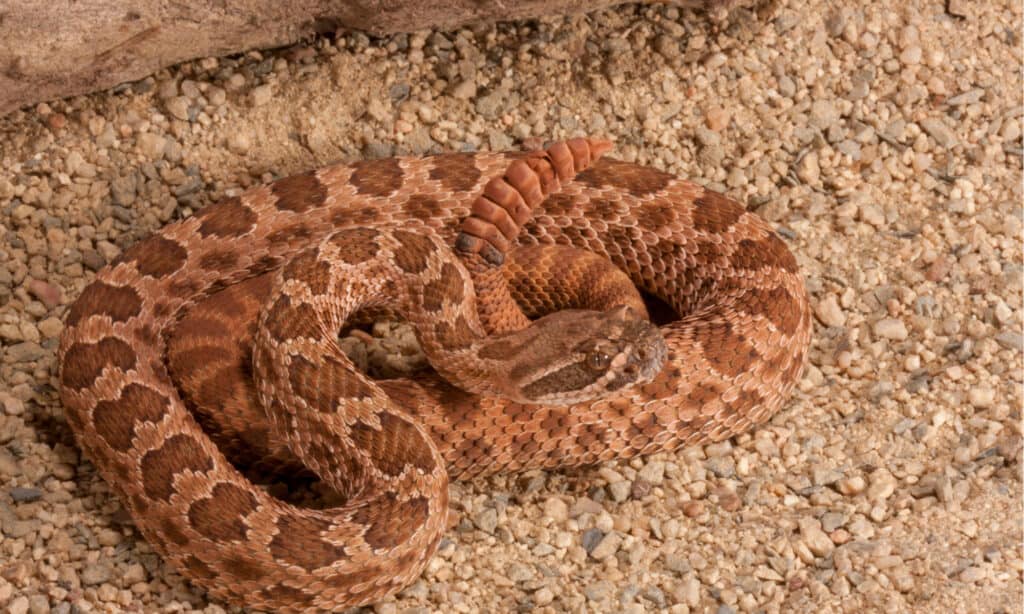
The Hopi Rattlesnake (pictured) is mostly found near cliffs and rocky areas that are made of red rock.
©K Hanley CHDPhoto/Shutterstock.com
9. Speckled Rattlesnake
Classification: Crotalus mitchellii
The arid and rocky regions of Arizona are home to the deadly Speckled Rattlesnake. They are also widespread in Texas and New Mexico. Both a hemotoxin and a neurotoxic are present in their venom, which in extreme circumstances can result in respiratory failure, pain, swelling, tissue damage, and even death if untreated.
Since these snakes are typically not aggressive toward people and prefer to avoid conflict, bites from them are relatively uncommon in Arizona. However, caution should always be used when coming into contact with any snake in the wild, especially in Arizona. If bitten by this snake, medical assistance should be sought right once. The striking speckled appearance and tiny size of the Speckled Rattlesnake make it pretty easy to identify when out hiking.
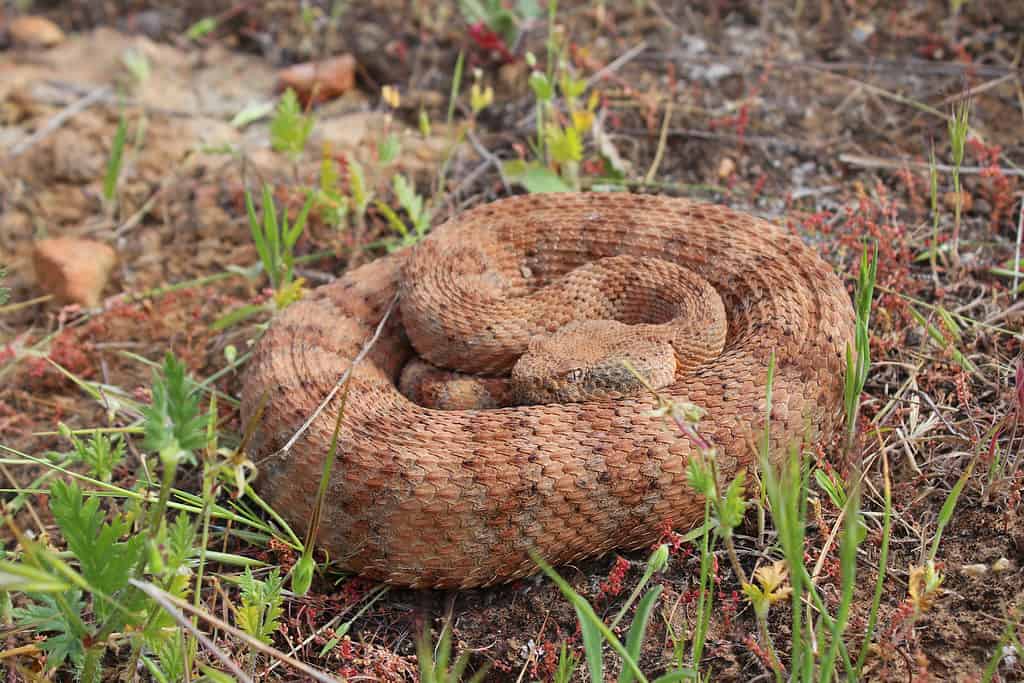
The Speckled Rattlesnake (pictured) has venom composed of both hemotoxins and neurotoxins.
©Creeping Things/Shutterstock.com
10. Tiger Rattlesnake
Classification: Crotalus tigris
The desert areas of Arizona are home to the deadly Tiger Rattlesnake, also known as the Arizona Desert Massasauga. Their distinctive color is a yellowish or orange hue with dark bands or stripes that resemble tiger stripes.
The venom of this species is very toxic, and in severe situations, it can result in respiratory failure and tissue damage. Their bite is very uncommon throughout Arizona. Although the Tiger Rattlesnake generally exhibits placid behavior, they will defend themselves if necessary. When spending time outside in rattlesnake habitat, it is crucial for locals and visitors to be aware of areas that are home to the Tiger Rattlesnake.
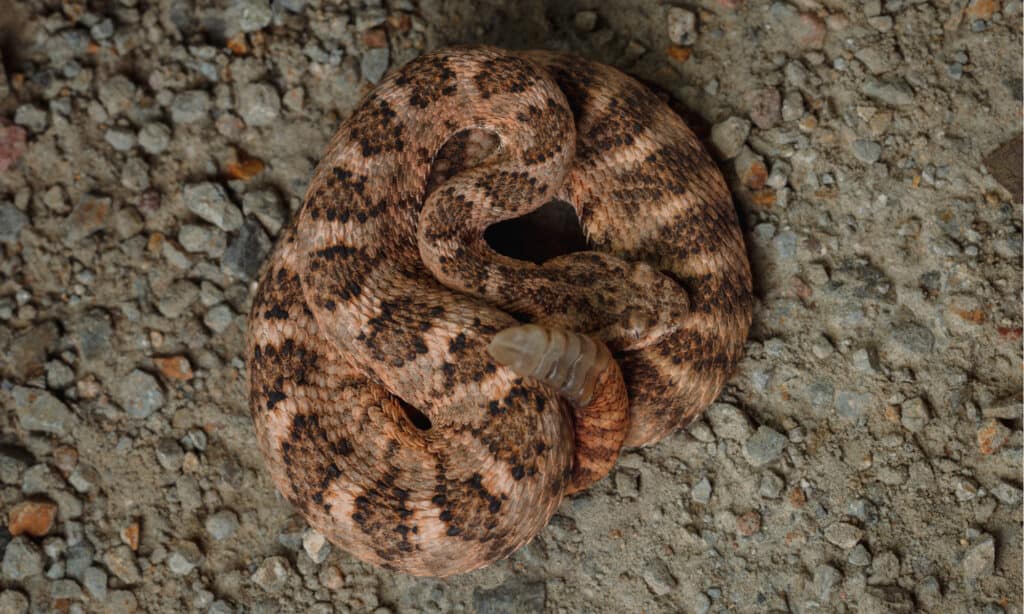
Tiger Rattlesnakes (pictured) are not known to bite humans.
©Alexander Wong/Shutterstock.com
11. Arizona Black Rattlesnake
Classification: Crotalus cerberus
Arizona’s rough terrain and canyons are home to the deadly Arizona Black Rattlesnake. They feature noticeable crossbands of white or gray and a black hue throughout their bodies. Their venom is very dangerous, and in severe situations without treatment can result in death. Luckily, snake bites from these species are not common in Arizona.
Although the Arizona Black Rattlesnake generally exhibits docile behavior, they will defend themselves if necessary. When frightened, these snakes are also well-known for rattling loudly and continuously. They will let you know when you are too close!
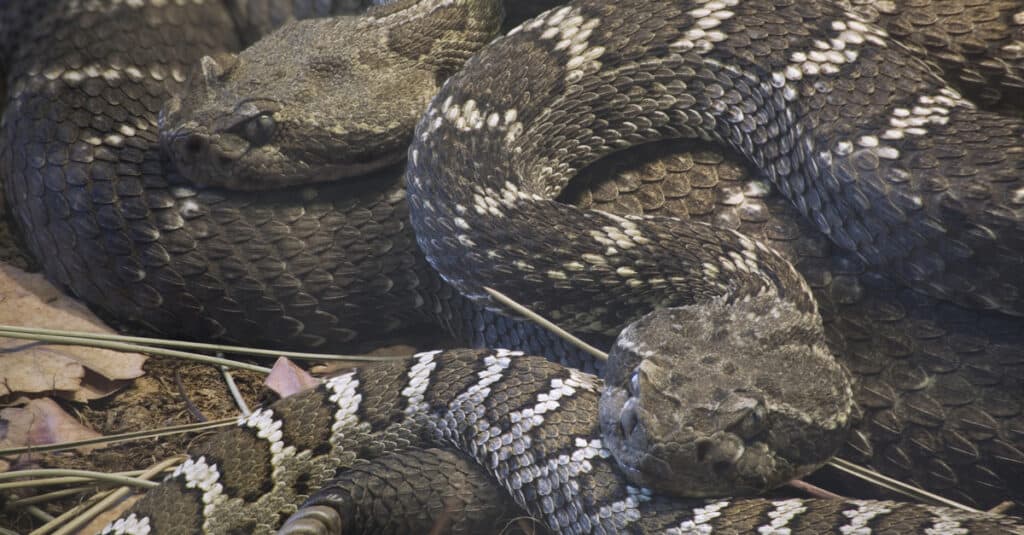
Arizona Black Rattlesnakes (pictured) share communal dens and females may share parenting duties.
©Dario Sabljak/Shutterstock.com
12. Sidewinder
Classification: Crotalus cerastes
Arizona’s desert areas are home to the venomous Sidewinder, also known as the Horned Rattlesnake. They have a special adaption that allows them to move sideways, leaving recognizable tracks in the sand, and they have protrusions that resemble horns above their eyes.
Although their venom can cause pain, swelling, and tissue damage and is moderately toxic, healthy adults are usually not at risk for serious injury from it. Since these snakes are typically not aggressive toward people and prefer to avoid conflict, bites from them are relatively uncommon in Arizona.
The Sidewinder has a peculiar habit in that it is predominantly nocturnal and spends a lot of time buried in the sand during the day to avoid the heat. Although they are an interesting species to study due to their sideways movement and horn-like protrusions, care should always be taken when coming into contact with any snake in the wild.
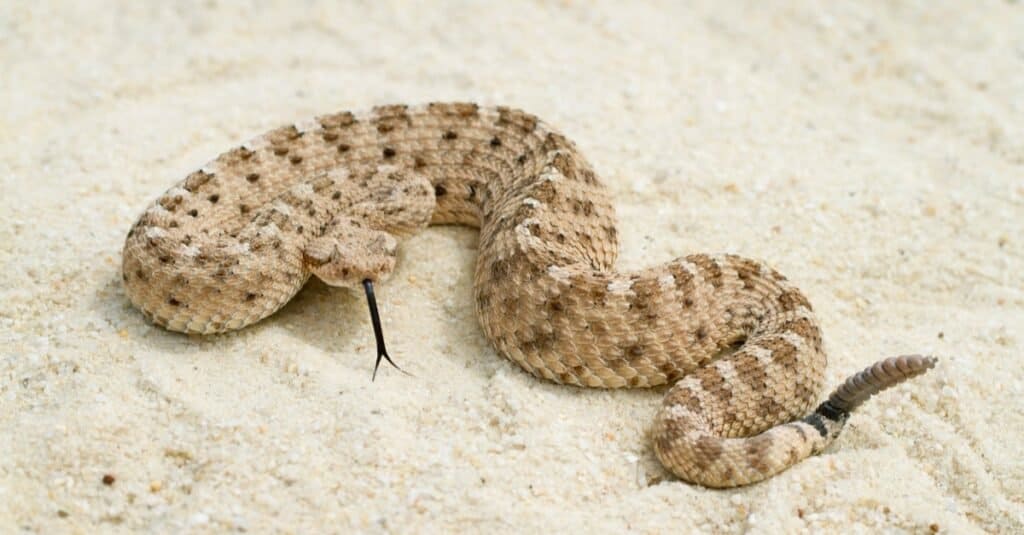
The Sidewinder Rattlesnake (pictured) can move in an unusual manner to hunt or escape situations quickly.
©Mark_Kostich/Shutterstock.com
13. Ridge-Nosed Rattlesnake
Classification: Crotalus willardi
Arizona’s arid areas are home to the venomous Ridge-Nosed Rattlesnake. They are typically tan or brown in color with darker crossbands, and their name comes from a unique ridge-like scale that covers their nose. Their venom is powerful and can result in respiratory failure and death in severe cases. It can also cause severe pain, swelling, and tissue damage.
These snakes are often not aggressive toward people (you’ve probably noticed a pattern thus far in this list!) and prefer to avoid conflict. Because of this, bites from them are quite infrequent in Arizona. The Ridge-Nosed Rattlesnake is also renowned for its unusual mating behavior, in which the males battle for the attention of the females by performing a combat dance.

The Ridge-Nosed Rattlesnake (pictured) has particularly powerful venom.
©Matt Jeppson/Shutterstock.com
14. Twin-Spotted Rattlesnake
Classification: Crotalus pricei
Arizona’s more arid and dry regions are home to the deadly Twin-Spotted Rattlesnake. On their head, they have two big spots, and their body is covered in a succession of black blotches. They might be tan, gray, or reddish-brown in hue. Their venom is very dangerous, and in severe situations, it can result in extreme pain and death. However, in Arizona, these snake bites are not very prevalent.
The Twin-Spotted Rattlesnake is renowned for its special protection technique in which it flattens its body and swiftly shakes its tail to produce a buzzing noise that resembles a baby’s rattle. This can mislead and scare away predators. When spending time outside in rattlesnake habitats, this rattle can be beneficial for the safety of both the snake and humans passing by.

Twin-Spotted Rattlesnakes (pictured) can flatten their bodies to appear more dangerous.
©iStock.com/adogslifephoto
Venomous Snakes in California
1. Western Diamondback Rattlesnake
Classification: Crotalus atrox
Just like Arizona, California has a population of Western Diamondback Rattlesnakes throughout the state.
2. Mojave Rattlesnake
Classification: Crotalus scutulatus
You’re probably noticing a bit of a pattern here, already. Many of the venomous snakes that are found in California are also found in Arizona.
3. Red Diamond Rattlesnake
Classification: Crotalus ruber
Red Diamond Rattlesnakes, sometimes referred to as the Red Diamondback, can be found throughout California’s desert regions. With a vivid reddish or pinkish coloring and unique diamond-shaped patterns down their back, they offer an arresting look and aesthetic appeal.
However, you shouldn’t mess with these snakes. They have enormous, triangular heads with venomous fangs and may reach lengths of up to four feet. Their venom is powerful and can result in respiratory failure and death in severe cases. Luckily, these snake bites are not common in California. In times of extreme heat or cold, the Red Diamond Rattlesnake is also renowned for its capacity to control its body temperature by digging in wet sand or mud.

Red Diamond Rattlesnakes (pictured) are known for their very triangular heads.
©Creeping Things/Shutterstock.com
4. Western Rattlesnake
Classification: Crotalus oreganus
Across the west coast, the main types of venomous snakes found in California are rattlesnakes. The same could be said for Arizona as well.
5. Panamint Rattlesnake
Classification: Crotalus stephensi
In the deserts of California, there is a venomous species of snake called the Panamint Rattlesnake. This venomous snake’s body is typically light brown or tan with darker brown or black markings, giving them an easy to identify look. They have short and thin skulls with large venomous fangs and can reach a length of three feet.
Their venom is very dangerous and, in severe situations, can result in respiratory failure, tissue damage, and even death. These snakes are typically not aggressive, thus bites from them are not common in California. The Panamint Rattlesnake is renowned for its propensity for eating mice and for its capacity to scale trees and shrubs in quest of prey.

The Panamint Rattlesnake (pictured) is a smaller species of rattlesnake that eats mice.
©Marina Kehl/Shutterstock.com
6. Speckled Rattlesnake
Classification: Crotalus mitchellii
Another venomous snake that California shares with Arizona, the speckled rattlesnake is notably difficult to see on hiking trails due to its camouflage.
7. Sidewinder
Classification: Crotalus cerastes
The Sidewinder, which is also found in Arizona, can have a wide range of colorations.
In both California and Arizona, these snakes can have a cream, yellowish, gray, or even slight pink hue.
Arizona vs. California: Which State Has More Venomous Snakes?
Several venomous snake species may be found in Arizona and California, including the species mentioned above. Arizona has 14 species of venomous snakes, according to the Arizona Game and Fish Department.
Alternatively, there are seven venomous snake species in California, according to the California Department of Fish and Wildlife. As a result, Arizona has more venomous snake species than California.
Summary of Venomous Snakes in Arizona and California
| Venomous Snakes in Arizona | Venomous Snakes in California |
|---|---|
| Western Diamondback Rattlesnake | Western Diamondback Rattlesnake |
| Arizona Coral Snake | Mojave Rattlesnake |
| Rock Rattlesnake | Red Diamond Rattlesnake |
| Mojave Rattlesnake | Western Rattlesnake |
| Black-Tailed Rattlesnake | Panamint Rattlesnake |
| Western Massasauga | Speckled Rattlesnake |
| Western Rattlesnake | Sidewinder |
| Hopi Rattlesnake | |
| Speckled Rattlesnake | |
| Tiger Rattlesnake | |
| Arizona Black Rattlesnake | |
| Sidewinder | |
| Ridge-Nosed Rattlesnake | |
| Twin-Spotted Rattlesnake |
Discover the "Monster" Snake 5X Bigger than an Anaconda
Every day A-Z Animals sends out some of the most incredible facts in the world from our free newsletter. Want to discover the 10 most beautiful snakes in the world, a "snake island" where you're never more than 3 feet from danger, or a "monster" snake 5X larger than an anaconda? Then sign up right now and you'll start receiving our daily newsletter absolutely free.
Thank you for reading! Have some feedback for us? Contact the AZ Animals editorial team.

